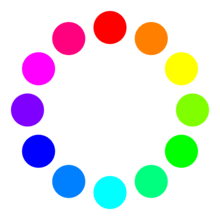CMY color model
The CMY color model is a subtractive color model in which cyan, magenta and yellow pigments or dyes are added together in various ways to reproduce a broad array of colors. The name of the model comes from the initials of the three subtractive primary colors, cyan, magenta, and yellow.

The CMY color model itself does not define what is meant by cyan, magenta and yellow colorimetrically, and so the results of mixing them are not specified as absolute, but relative to the primary colors. When the exact chromaticities of the cyan, magenta, and yellow primaries are defined, the color model then becomes an absolute color space.
Subtractive colors
The CMY color model is subtractive in the sense that mixtures of dye (typically sitting on a white substrate such as paper) subtract specific wavelengths from the spectral power distribution of the illuminating light which is scattered back into the viewer's eye and is perceived as colored. Layering dyes on top of each is used to reproduce a gamut of colors, the resultant color from this layer is predicted by multiplying (not subtracting)[1] the absorbance profiles of the dyes. This is essentially opposite to the additive color model, particularly the RGB color model, that applies to lights whose color depends directly on the light.
When the intensities for all the components are the same, the result is a shade of gray, lighter, or darker depending on the intensity. When the intensities are different, the result is a colorized hue, more or less saturated depending on the difference of the strongest and weakest of the intensities of the primary colors employed.
When one of the components has the strongest intensity, the color is a hue near this primary color (cyan-ish, magenta-ish, or yellow-ish), and when two components have the same strongest intensity, then the color is a hue of a secondary color (a shade of red, green or blue). A secondary color is formed by the sum of two primary colors of equal intensity: red is magenta+yellow, green is yellow+cyan, and blue is cyan+magenta. Every secondary color is the complement of one primary color; when a primary and its complementary secondary color are added together, the result is black: red complements cyan, green complements magenta, and blue complements yellow.
CMYK color model
CMYK color model is a subtractive color model, based on the CMY color model, used in color printing, and is also used to describe the printing process itself. CMYK refers to the four inks used in some color printing: cyan, magenta, yellow, and key. It uses K, black ink, since C, M, and Y inks are translucent and will only produce a gray color when mixed.
References
- Levoy, March. "Additive versus subtractive color mixing - cs178 notes". graphics.stanford.edu. Retrieved 28 June 2019.
